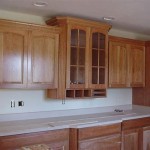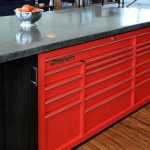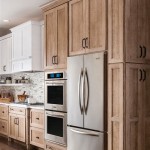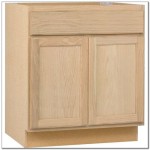Removing Grime From Kitchen Cabinets
Kitchen cabinets, constantly exposed to cooking fumes, splatters, and daily handling, inevitably accumulate grime. This build-up not only detracts from the kitchen's aesthetic appeal but can also harbor bacteria. Regular cleaning is essential for maintaining hygiene and preserving the cabinet's finish. Effective grime removal involves understanding the cabinet material and employing the appropriate cleaning methods and products.
Before commencing any cleaning process, identifying the cabinet material is crucial. Different materials require specific cleaning approaches to avoid damage. Common kitchen cabinet materials include wood, laminate, metal, and painted surfaces. Each material reacts differently to various cleaning solutions, making identification the first essential step.
Wood cabinets require gentle cleaning to prevent damage to the finish. Harsh chemicals can strip the finish or cause discoloration. A mild dish soap solution, consisting of a few drops of dish soap in warm water, is generally safe for cleaning finished wood. The solution should be applied with a soft cloth or sponge, working in the direction of the wood grain. Excessive moisture should be avoided, and the cabinets should be dried immediately with a clean, dry cloth.
For stubborn grime on wood cabinets, a mixture of baking soda and water can be used. This creates a gentle abrasive paste that can lift stuck-on food particles and grease. Apply the paste to the affected area, let it sit for a few minutes, and then gently scrub with a soft cloth or sponge. Rinse with a clean, damp cloth and dry thoroughly.
Laminate cabinets are generally more resistant to damage than wood, but abrasive cleaners can still scratch the surface. A solution of warm water and mild dish soap is effective for everyday cleaning. For tougher grime, a commercial cleaner specifically designed for laminate surfaces can be used. Always follow the manufacturer's instructions when using commercial cleaning products.
Metal cabinets are durable and easy to clean. However, they can be prone to fingerprints and smudges. A mixture of warm water and mild dish soap is typically sufficient for cleaning metal cabinets. For stubborn grease or grime, a degreaser can be used, but it should be tested on an inconspicuous area first to ensure it doesn't damage the finish. Avoid abrasive cleaners and scouring pads, which can scratch the metal surface.
Painted cabinets, whether wood or metal, require careful cleaning to prevent damage to the paint. A mild dish soap solution is generally safe for painted surfaces. Avoid using harsh chemicals or abrasive cleaners, which can strip the paint. For stubborn stains, a paste of baking soda and water can be used. Apply the paste, let it sit for a few minutes, and then gently scrub with a soft cloth. Rinse with a clean, damp cloth and dry thoroughly.
Grease build-up is a common problem on kitchen cabinets, particularly those located near the stovetop. Degreasing solutions are effective for removing grease but should be used with caution. Always test the degreaser on an inconspicuous area first to ensure it doesn't damage the cabinet's finish. Apply the degreaser according to the manufacturer's instructions and rinse thoroughly with clean water.
Regular cleaning is the most effective way to prevent the build-up of grime on kitchen cabinets. Wiping down the cabinets after each cooking session can prevent grease and food splatters from hardening and becoming difficult to remove. A weekly cleaning with a mild dish soap solution can maintain the cabinets' cleanliness and prevent the accumulation of grime.
Beyond cleaning solutions, the choice of cleaning tools also plays a crucial role in preventing damage to the cabinets. Soft cloths, sponges, and microfiber cloths are ideal for cleaning most cabinet surfaces. Avoid using abrasive scouring pads or steel wool, which can scratch the finish. A soft-bristled brush can be used for cleaning crevices and detailed areas.
Maintaining clean kitchen cabinets contributes significantly to the overall hygiene and aesthetic appeal of the kitchen. By understanding the cabinet material and employing the appropriate cleaning methods and products, homeowners can effectively remove grime and preserve the beauty and longevity of their kitchen cabinets. Regular cleaning and preventative measures are key to maintaining a clean and inviting kitchen environment.
Specific cleaning product recommendations should be researched based on the cabinet material and the type of grime being addressed. Consulting with cabinet manufacturers or professionals can provide further guidance on appropriate cleaning methods and products. Careful consideration of cleaning solutions and tools will ensure effective grime removal while preserving the integrity of the kitchen cabinets.

How To Clean Kitchen Cabinets Everyday Skate

How To Remove Grease From Kitchen Cabinets 3 Methods Bob Vila

How To Clean Sticky Grease Off Kitchen Cabinets Ovenclean

How To Clean Grimy Kitchen Cabinets With 2 Ingredients

Get Grease Off Kitchen Cabinets Easy And Naturally

Clean Kitchen Cabinets Off With These Tips And Hints

How To Clean White Kitchen Cabinets 3 Best Ways Avoid Abbotts At Home

Removing Grease From Kitchen Cabinets House Cleaning Tips Safe S Clean

Get Grease Off Kitchen Cabinets Easy And Naturally

How To Clean Sticky Grease Off Kitchen Cabinets
Related Posts








